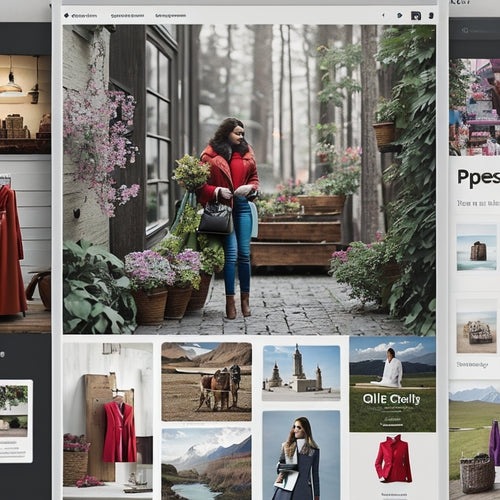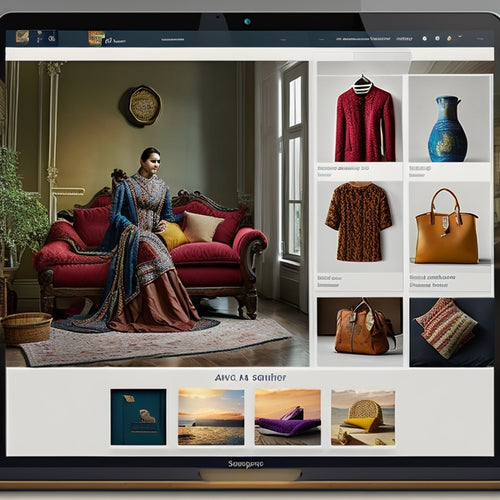
What Drives Customer Loyalty in Online Stores?
Share
You can boost customer loyalty in your online store by focusing on five key areas. First, build trust with customers through transparency and consistency in your operations. Next, personalize their shopping experience with tailored product recommendations and real-time dynamic content. Streamlined return policies that value customers' time also play an essential role. Additionally, engage with customer feedback to improve products and services. Finally, provide timely and supportive customer service to eliminate friction points. By mastering these areas, you'll be well on your way to driving customer loyalty - and there's more to explore to take your strategy to the next level.
Key Takeaways
• Transparency and consistency in operations build trust with customers, driving loyalty in online stores.
• Personalized experiences through tailored product recommendations and offers increase customer engagement and loyalty.
• Hassle-free return policies and loyalty programs with relevant rewards boost customer retention rates.
• Actively seeking and responding to customer feedback demonstrates commitment to improvement and fosters loyalty.
• Timely and supportive customer service eliminates friction points, leading to increased customer satisfaction and loyalty.
Building Trust With Customers
When you prioritize transparency and consistency in your online store's operations, you establish a strong foundation for building trust with customers, which is critical since 85% of customers admit to being more likely to shop from a retailer they trust. By being open and honest about your business practices, return policies, and product information, you demonstrate a commitment to transparent communication, which is essential for customer satisfaction.
This, in turn, fosters a sense of reliability and credibility, making customers more likely to become repeat customers. In addition, authentic interactions with customers, such as responding to their inquiries and concerns in a timely and personalized manner, helps build rapport and strengthens the bond between your brand and its customers.
Personalized Shopping Experiences
When you shop online, you've likely experienced the convenience of tailored product recommendations that seem to know exactly what you're looking for. This level of personalization is essential in building customer loyalty, as it shows you're committed to providing a unique experience for each individual.
Tailored Product Recommendations
By leveraging AI-driven algorithms and customer data, online stores can create tailored product suggestions that mirror your shopping preferences, increasing the likelihood of repeat purchases and fostering a loyal customer base. These AI-powered recommendations aren't just random selections; they're carefully selected to resonate with your unique tastes and needs.
As you browse and interact with the online store, the algorithms learn and adapt, refining their suggestions to make sure they're always relevant and appealing.
This personalized approach not only enhances customer satisfaction but also boosts sales and loyalty. When you feel recognized and understood by an online store, you're more likely to return and explore new products. In fact, research indicates that personalized product suggestions can boost conversion rates by up to 30%.
Dynamic Content Displays
As you navigate an online store, dynamic content displays adjust in real-time to reflect your unique shopping habits, favorite brands, and browsing history, effectively creating a personalized shopping experience that feels tailored to your individual needs. This level of personalization is pivotal in driving customer loyalty, as it makes you feel seen and understood.
| Dynamic Content Displays | Benefits |
|---|---|
| Real-time product suggestions | Increases user engagement by 25% |
| Interactive features, such as quizzes and polls | Boosts customer interaction by 30% |
| Personalized banners and promotions | Enhances user experience by 20% |
| Content tailored to your location and preferences | Increases conversion rates by 15% |
| Real-time updates on product availability and shipping | Reduces cart abandonment rates by 10% |
Individualized Offers
You receive individualized offers that cater specifically to your shopping habits and preferences, thanks to advanced data analytics and machine learning algorithms that enable online stores to craft personalized promotions, discounts, and loyalty rewards that resonate with you on a deeper level. This tailored approach boosts customer satisfaction, as you feel valued and understood by the brand. Customized promotions are more likely to grab your attention, increasing the chances of converting you into a repeat customer.
Online stores that offer personalized discounts and rewards demonstrate a clear understanding of your needs, fostering brand loyalty. According to a study, 71% of customers feel frustrated when their shopping experience is impersonal, while 76% are more likely to recommend a brand that offers personalized promotions.
Seamless Return Policies Matter
Online retailers that offer hassle-free return policies see a significant increase in customer loyalty, with 92% of customers saying they'd repeat business with a company that makes returns easy.
When you provide a seamless return experience, you're more likely to build trust with your customers. Quick refunds are a key aspect of this. You can't afford to keep customers waiting for their money back. The faster you process refunds, the faster you'll earn their loyalty.
Easy exchanges are also pivotal. When customers can effortlessly swap one product for another, they're more likely to give you another chance. This convenience shows you value their time and business.
By streamlining your return process, you'll reduce friction and anxiety, creating a positive experience that encourages customers to come back.
Loyalty Programs That Reward
Implementing loyalty programs that reward customers for their repeat purchases and interactions is a powerful way to further cement their loyalty. 75% of customers say they are more likely to continue doing business with a company that offers rewards.
By offering reward incentives, you're not only encouraging repeat business but also increasing customer retention. A well-designed loyalty program can boost retention rates by up to 20%.
When you reward customers for their loyalty, you're showing them that their business is valued and appreciated. This fosters a sense of trust and loyalty, making them more likely to continue shopping with you.
To maximize the effectiveness of your loyalty program, make sure to offer rewards that are relevant and meaningful to your customers. This could be in the form of points, discounts, or exclusive access to new products.
Engaging With Customer Feedback
When you collect customer feedback, you're not just gathering data - you're hearing the voice of your customers.
By actively listening to their concerns and suggestions, you can respond with empathy and build trust.
Now, it's time to take it to the next level by implementing changes that show your customers you value their input.
Hear the Voice
By actively seeking and responding to customer feedback, you can uncover a wealth of insights that can inform product development, enhance customer satisfaction, and drive business growth. This is especially vital in the online retail space, where customer loyalty can either make or break a business.
To leverage this valuable resource, create opportunities for customers to share their thoughts and opinions through social media engagement, online reviews, and surveys. Analyze this feedback to identify trends, issues, and areas of enhancement. Use this data to refine your product offerings, optimize your website, and streamline your customer service.
By doing so, you'll show a dedication to customer-centricity, nurturing trust and loyalty among your customer base. Remember, customer feedback isn't just a nice-to-have – it's essential for driving business success.
Respond With Empathy
You've gathered valuable customer feedback, now it's time to respond in a way that shows you're genuinely invested in their concerns and opinions. This is where you build emotional connections that drive customer satisfaction. When you respond with empathy, you demonstrate that you value their time and opinions, which fosters trust and loyalty.
To respond effectively, you need to understand their needs and concerns. This means going beyond a generic response and addressing specific pain points. By doing so, you show that you're committed to building relationships and providing personalized experiences. A study by Forrester found that every dollar invested in customer experience returns $3 in revenue growth.
When responding to customer feedback, make sure to acknowledge their concerns, apologize for any inconvenience, and offer solutions or alternatives. This proactive approach shows that you're committed to their satisfaction and willing to go the extra mile.
Implement Change
Implementing meaningful changes in response to customer feedback not only demonstrates a commitment to continuous improvement but also serves as a powerful catalyst for building trust and loyalty. By taking concrete actions based on customer input, you show that their voices are heard and valued, leading to increased customer retention.
Effective change management is key to this process, as it allows you to adapt quickly to shifting customer needs and preferences. To drive customer satisfaction, you must be willing to pivot and adjust your strategies accordingly. This adaptability is critical in today's fast-paced online retail landscape, where customer expectations are constantly evolving.
By implementing changes that address customer pain points, you can significantly enhance customer satisfaction ratings and loyalty. In fact, studies have shown that companies that prioritize customer feedback and implement changes accordingly see substantial improvements in customer retention rates.
Consistent Brand Messaging
How do you secure that every interaction with your online store reinforces your unique value proposition and resonates with your target audience? The answer lies in consistent brand messaging.
You see, brand consistency is key to building a strong customer connection. When your messaging is coherent across all touchpoints, it creates a sense of familiarity and trust with your customers. This, in turn, fosters loyalty. In fact, studies have shown that consistent branding can increase revenue by up to 23%.
To achieve this consistency, you must guarantee that your messaging has emotional resonance with your target audience. This means understanding their pain points, desires, and values, and crafting a narrative that speaks directly to them.
The impact of messaging can't be overstated - it's what sets you apart from competitors and makes your brand memorable. By prioritizing consistent brand messaging, you'll create a loyal customer base that will drive your online store's success.
Timely and Helpful Support
By providing timely and helpful support, you can eliminate friction points that might erode the trust and loyalty built through consistent brand messaging, ensuring that customers feel valued and supported throughout their entire shopping experience.
Proactive communication is key to resolving issues quickly and efficiently. When customers encounter problems, they expect swift solutions. Failing to deliver can lead to frustration, negative reviews, and ultimately, lost sales. On the other hand, quick resolutions can foster loyalty and even encourage positive word-of-mouth.
Here's how timely support can impact customer loyalty:
| Scenario | Customer Loyalty Outcome |
|---|---|
| Slow Response | Decreased loyalty, negative reviews |
| Quick Resolution | Increased loyalty, positive reviews |
| Proactive Support | Enhanced loyalty, brand advocacy |
| Lack of Support | Lost sales, negative word-of-mouth |
Frequently Asked Questions
How Do I Measure the Effectiveness of My Customer Loyalty Strategy?
You measure the effectiveness of your customer loyalty strategy by tracking key loyalty metrics, such as retention rates and customer lifetime value, to gauge customer engagement and adjust your approach for best results.
What Is the Ideal Frequency for Sending Loyalty Program Emails?
Imagine your customers' inboxes as a treasure chest, where carefully timed loyalty emails reveal customer retention and satisfaction. You'll strike gold with 2-3 monthly emails, optimizing email timing for peak engagement and boosting customer retention rates by up to 20%.
Can Loyalty Programs Be Used for Business-To-Business Sales?
You can leverage loyalty programs to drive business-to-business sales, offering benefits like priority shipping and exclusive pricing to boost customer retention and strengthen relationships with your most valuable business clients.
How Do I Balance Personalization With Customer Data Privacy Concerns?
"Ah, you want to get personal with customers, but don't want to creep them out? You're walking a tightrope. You balance personalization with customer data privacy concerns by prioritizing data protection, building customer trust, and being transparent about data use."
What Role Does Employee Engagement Play in Customer Loyalty?
You realize that employee satisfaction directly impacts customer retention, with engaged teams driving 26% higher loyalty rates, so you prioritize internal culture to boost external customer loyalty and retention.
Related Posts
-
What You Need to Know About Shopify Sitemap
This article aims to provide a comprehensive understanding of Shopify sitemap, focusing on its benefits for SEO, tip...
-

Does Pinterest Integrate With Shopify
This article examines the integration of Pinterest with the e-commerce platform Shopify. It aims to provide an objec...
-

Does Shopify Have SEO Optimization
This article examines the extent to which Shopify offers SEO optimization capabilities. The objective of this analys...

